Advances in Bioscience and Biotechnology
Vol.3 No.2(2012), Article ID:18460,5 pages DOI:10.4236/abb.2012.32023
The nature of adhesion factors which lie on the surfaces of Lactobacillus adhering to cells
![]()
College of Animal Science and Technology, Shandong Agricultural University, Tai’an, China
Email: linxueyan@sdau.edu.cn, *zxniu@sdau.edu.cn, *zhwang@sdau.edu.cn
Received 18 January 2012; revised 26 February 2012; accepted 5 March 2012
Keywords: Lactobacillus; Adhesion; Intestinal Epithelial Cells; Adhesion Factors Nature
ABSTRACT
Lactobacillus adheres to intestinal epithelial cells and yeast fungus cells with the aid of adhesion factors expressed on its cell surface. To identify adhesion factors nature on the surface of Lactobacillus, an adhesion experiment was carried out by pre-treating the Lactobacillus supernatant with different concentrations of bovine serum albumin, trypsin and 100˚C for 10min. Additionally, intestinal epithelial cells were treated with sodium iodate, trypsin and sugar inhibition tests to characterize the receptors in Lactobacillus that interact with intestinal epithelial cells. It was demonstrated that Lactobacillus adhesion ability was decreased (P < 0.01) after treating the supernatant with different concentrations of bovine serum albumin, trypsin and 100˚C for 10 min respectively. The adhesion factor on the surface of Lactobacillus cells was identified as a D-mannose glycoprotein. This observation was confirmed after treating intestinal epithelial cells with sodium iodate and trypsin, and sugar inhibition tests. Wild type Lactobacillus can agglutinate yeast fungus cells but after being exposured to mannose, agglutination to yeast fungus cells is lost or reduced. Results from this study we also got that inactivated and live bacteria that similarly adhere to intestinal epithelial cells.
1. INTRODUCTION
The cell surface of bifidobacterium cells consists of LTA (lipid teichoic acid) and protein while adhesion substances on the surface of Lactobacillus cells are not well characterized and likely consist of protein [1]. It was demonstrated that adhesion substances on the bifidobacterium cell surface was present in the supernatant. Based on this conclusion, we isolated the supernatant in Lactobacillus cultures by high speed centrifugation, and performed various measures to identify the unknown adhesion substance [2-5]. Earlier research suggests that the bifidobacterium adhesion receptor needed for attachment to intestinal epithelial cells is a glycoprotein. Similarly, our study identifies the Lactobacillus receptor that allows for efficient attachment to intestinal epithelial cells.
2. MATERIALS AND METHODS
2.1. CaCo-2 Cells
A human colon cancer cell line, which is equivalent to intestinal epithelial cells, was purchased from the Shanghai Cell Research Institute.
CaCo-2 cell culture: DMEM media containing 10% bovine serum (penicillin 1,000,000 IU/L, streptomycin 100 μg/L) (pH: 7.0 ~ 7.2); flushing liquor PBS (pH 7.4); cell digestive juice (0.02% EDTA: D-Hanks = 10:1) (not including Ca2+, Mg2+); Passing was done when oblate cells overgrew in the culture flasks and was done by adding 3 ml digestive juice and digesting for 20 ~ 30 min. Digestion was stopped when the cell wall fell off, at which point we incubated the culture flask for 3 min, and flushed the flask with 10% DMEM. Cells were collected after removing the digestive juice.
2.2. Lactobacillus Bacterial Strain
Bacterial strain got from Bacteria Research Institute of Shandong Agricultural University. The SDn A3 bacterial strains, which adhesion ability were validated as efficient in a previous experiment, were cultured at 37˚C for 2 days. (“A” stands for bacterial strains derived from SPF chicken craws)
2.3. The Method for Identifying Adhesion Factors Expressed on the Surface of Lactobacillus Cells
Culture supernatants were acquired after the Lactobacillus thalli suspension was centrifuged at 5000 rpm for 30 min.
1) The number of Lactobacillus cells that adhered to intestinal epithelial cells were counted after incubating cultures with different concentrations of trypsin (37˚C, 30 min). The concentrations of trypsin selected were as follows: 0, 5, 10, 15 and 20 mg/ml.
2) The number of Lactobacillus cells that adhered to intestinal epithelial cells were counted after incubating cultures with different concentrations of bovine serum albumin (37˚C, 30 min). The concentrations of bovine serum albumin selected were as follows: 0, 5, 10, 15 and 18 mg/ml.
3) The number of Lactobacillus cells that adhered to intestinal epithelial cells were counted after incubating cultures at 100˚C for 10 min.
Fresh liquid culture medium (MRS) was marked as a control I. Each treatment group was combined with Lactobacillus cells after rinsing with PBS and centrifuging 5 times prior to performing the adhesion experiment. Lactobacillus thalli structures were rinsed with PBS (PH 7.4) and centrifuged 5 times (control II).
Adhesion experiment: Intestinal epithelial cells were added each well of a 24-well plate (with the cover-glass slip placed inside) and were allowed to adhere for 2 - 3 days. SDn A3 (200 μl) bacterial strains in each well were given different treatments and maintained at a concentration of 1 × 107/ml. Cells were then transferred to an incubator for 4 - 24 h, rinsed with PBS (pH 7.4) 6 times after removing the cover-glass slip, air-dried, fixed with carbinol, given a Gram stain test and counted under the microscope (20 eye captures; 40 counted cells; counted by 2 technicians).
2.4. The Method for Identifying Adhesion Factors Nature on the Surface of Intestinal Epithelial Cells
Intestinal epithelial cells were added to 24-well plates (with a cover-glass placed inside) and allowed to adhere for 2 - 3 days. Lactobacillus cells (200 μl) were added to each well and maintained at a concentration of 1 × 107/ml. Cells were then transferred to an incubator for 2 - 24 h, rinsed with PBS (pH 7.4) 6 times after removing the cover-glass slip, air-dried, fixed with carbinol, given a Gram stain test and counted under the microscope (20 eye captures; 40 counted cells; counted by 2 technicians). The average and standard deviations for each sample were also calculated.
2.4.1. Disposal of Cells with Sodium Periodate
The adhesion experiment was carried out with different concentrations of sodium periodate (37˚C, 30 min), which was added to CaCo-2 cells after rinsing with PBS (pH 7.4) once. 0.2 M acetate buffer (pH 4.6) was used to dilute sodium periodate and used as a control. The variable concentrations of sodium periodate were used were as follows: 0, 20, 40, 60, 80 and 100 mg/ml.
2.4.2. Treatment of Cells with Trypsin
The adhesion experiment was carried out with different concentrations of trypsin (37˚C, 30 min), which was added to CaCo-2 cells after rinsing with PBS (pH 7.4) once. 0.2 M acetate buffer (pH 4.6) was diluted with trypsin and used as a control. The different concentrations of trypsin used were as follows: 0, 5, 10, 15, 20 and 25 mg/ml.
2.4.3. Sugar Inhibition Tests
Adhesion experiments were done after adding glucose, lactose, sorbose, sucrose, D-fructose or D-mannose (at a final concentration of 20 mg/ml) to Lactobacillus suspensions. As a control, PBS (pH 7.4) was added to suspensions.
Adhesion experiment: Intestinal epithelial cells were added to 24-well plates (with a cover-glass slip inside) and allowed to adhere for 2 - 3 days. Lactobacillus cell suspensions (200 μl, each with two replicates) were treated with various sugar concentrations and transferred to an incubator for 4 - 24 h after removing the cover-glass slip. Suspsensions were then rinsed with PBS (pH 7.4) 6 times, air-dried, fixed with carbinol, given a Gram stain test and counted under a microscope (20 eye captures; 40 counted cells; counted by 2 technicians). The averages and standard deviations were also calculated.
2.5. Characterizing the Effect of Lactobacillus on Yeast Fungus Agglutination
One sample of Lactobacillus cells was treated with 0.2 M mannose while the other sample was not. Cells were then monitored for yeast fungus agglutination induced by Lactobacillus.
2.6. The Effect of Inactivated and Live Bacteria on Lactobacillus Adhesion Ability
Treatment: SDnA3 strains were derived from chicken intestinal epithelial cells after culturing for 2 days and suspensions were maintained at a concentration of 1 × 108 Cfu/ml. The supernatants were isolated after centrifuging at 5000 rpm for 15 min. pH 7.4 PBS buffer was used to rinse bacteria and the acquired suspensions were grouped as either live bacteria or inactivated bacteria. The inactivated bacteria group consisted of cells placed in a 65˚C water bath for 30 min.
Suspensions of live bacteria and inactivated bacteria were centrifuged and rinsed with PBS 3 times, the supernatant removed, PBS (pH 7.4), the Lactobacillus cultured supernatant and fresh MRS culture liquids were used to dilute the suspension of live and inactivated centrifuged bacteria individually (via the gradient dilution method). Bacterial adhesion ability was quantified at different bacterial suspension concentrations.
2.7. Statistics
Between treatment were assessed utilizing with the ANOVA procedure and Duncan’s Multiple Range Test was used for multiple comparisons analyze the Strains effects adherence to the cells.
3. RESULTS
3.1. The Effect of Different Concentrations of Trypsin on the Adhesion Ability of Lactobacillus (Table 1)
It was demonstrated in Table 1 that Lactobacillus supernatants treated with trypsin decreased the ability of Lactobacillus cells to adhere to CaCo-2 cells. The number of CaCo-2 cells that adhered to Lactobacillus decreased with increasing concentrations of trypsin.
3.2. Effects on the Adhesion Ability of Lactobacilus Due to Treatment with Different Concentrations of Bovine Serum Albumin (Table 2)
It was demonstrated in Table 2 that Lactobacillus supernatants treated with bovine serum albumin decreased
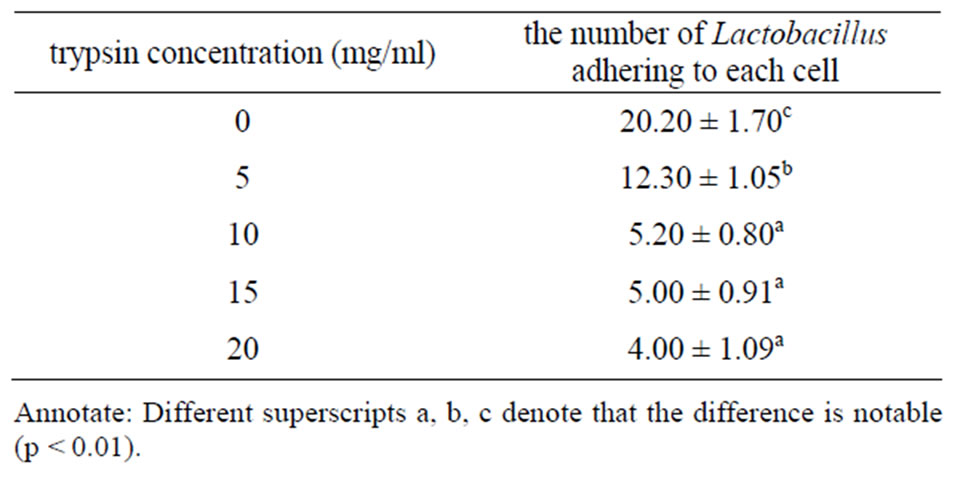
Table 1. Lactobacillus adhesion levels after treating Lactobacillus supernatants fluid with different concentrations of trypsin.
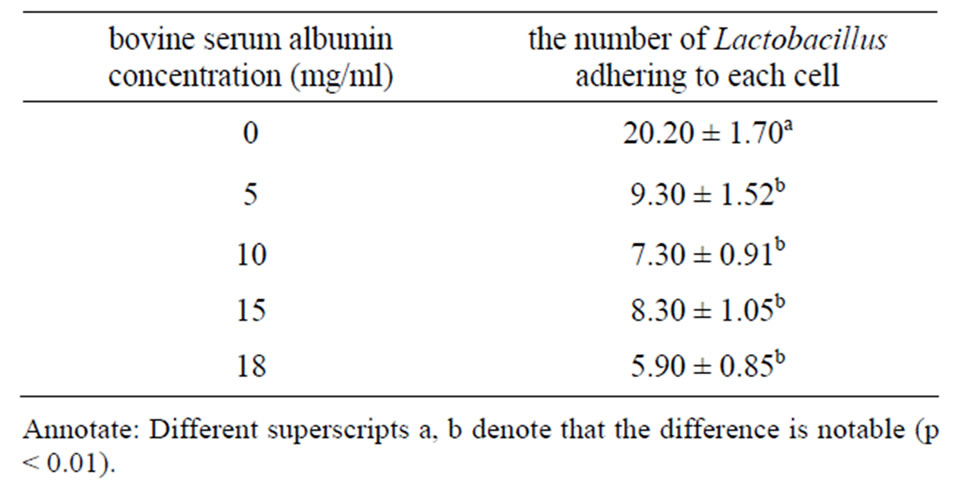
Table 2. Lactobacillus adhesion level after treating Lactobacillus supernatants with different concentrations of bovine serum albumin.
the ability of Lactobacillus to adhere to CaCo-2 cells. The number of CaCo-2 cells that adhered to Lactobacillus decreased with increasing concentrations of bovine serum albumin.
3.3. The Effect on Lactobacillus Adhesion Ability after Heating with Up to 100˚C (Table 3)
It was demonstrated in Table 3 that after treating the supernatants with high temperature, the adhesion ability of Lactobacillus decreased. A likely explanation is that there is an adhesion substance (possibly protein) in the Lactobacillus supernatant.
3.4. The Effect on Lactobacillus Attachment to CaCo-2 Cells Treated with Different Concentrations of Sodium Periodate (Table 4)
It was demonstrated in Table 4 that in contrast with the control group, the adhesion ability of Lactobacillus was decreased after CaCo-2 cells were treated with sodium periodate. The receptor on the surface of CaCo-2 cells is likely a glycoprotein. Sodium periodate breaks the carboncarbon bond of the hydroxyl group of sugar, and likely damages the adhesion factor.
3.5. Differences in the Adhesion Ability of Lactobacillus after CaCo-2 Cells Were Treated with Different Concentrations of Trypsin (Table 5)
It was demonstrated in Table 5 that in contrast with the

Table 3. Lactobacillus adhesion level after treating Lactobacillus supernatant fluid with 100˚C.
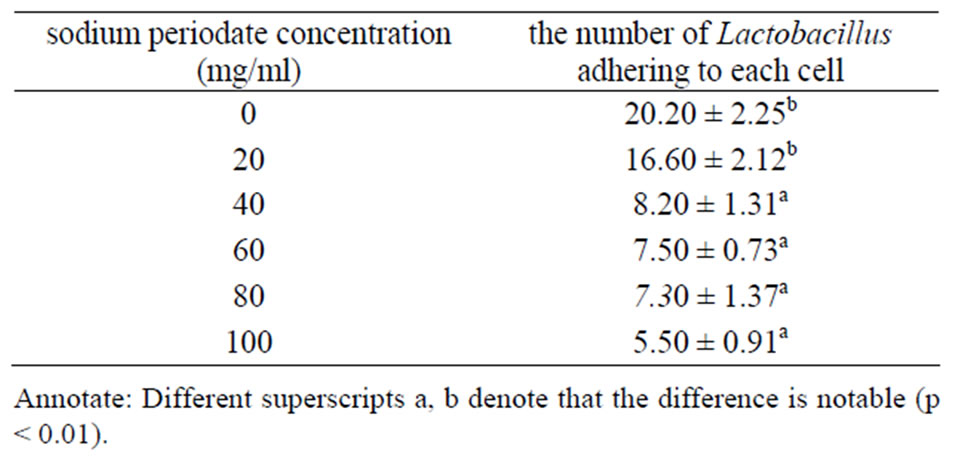
Table 4. Lactobacillus adhesion level after CaCo-2 cells were treated with different concentrations of sodium periodate.
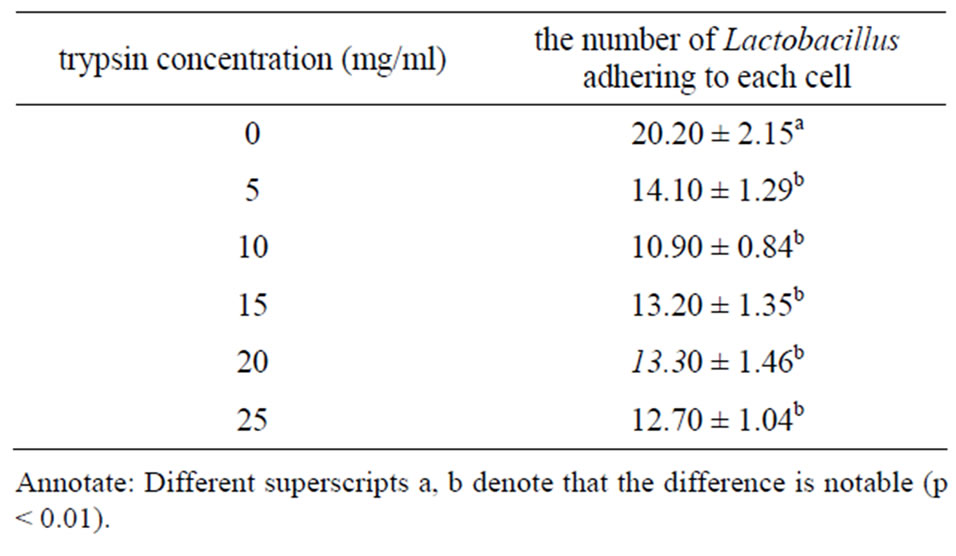
Table 5. Lactobacillus adhesion levels after CaCo-2 cells were treated with different concentrations of trypsin.
control group, the adhesion ability of Lactobacillus decreased after CaCo-2 cells were treated with trypsin (it acts on peptide sequences). These results suggest that the receptor that is expressed on the CaCo-2 cell surface is a type of protein.
3.6. The Effect on Lactobacillus Adhesion Ability after Treatment of CaCo-2 Cells with Different Sugars for 4 h (Table 6)
It was demonstrated in Table 6, Figures 1 and 2 that the difference in adhesion ability was not significant after Lactobacillus was treated with glucose, lactose, sorbose, sucrose and D-fructose; yet the difference in adhesion ability was significant after Lactobacillus was treated with D-mannose,demonstrating that the adhesion receptor of SDnA3 strains may be the D-mannose protein receptor.
3.7. Treatment Effects on Lactobacillus Agglutination to Yeast Fungus
When Lactobacillus was treated with 0.2 M mannose, its agglutination to yeast fungus cells weakened compared to untreated Lactobacillus cells (Figures 3 and 4).
3.8. The Effect of Inactived Bacteria and Live Bacteria Introduction on Lactobacillus Adhesion Ability (Table 7)
It was demonstrated in Table 7 that live and dead Lactobacillus cells have similar adherence levels. Adherence matter is in the 2 days cultured supernatant. This observation suggests that the protein in the supernatant retains its adhesion ability regardless of whether it is activated or inactivated.
4. DISCUSSION
1) Previous research suggests that dead Lactobacillus and inactivated bifidobacterium have similar adhesion ability compared to live bacteria. This observation is in

Table 6. Adhesion levels of Lactobacillus after CaCo-2 cells were treated with different sugars.
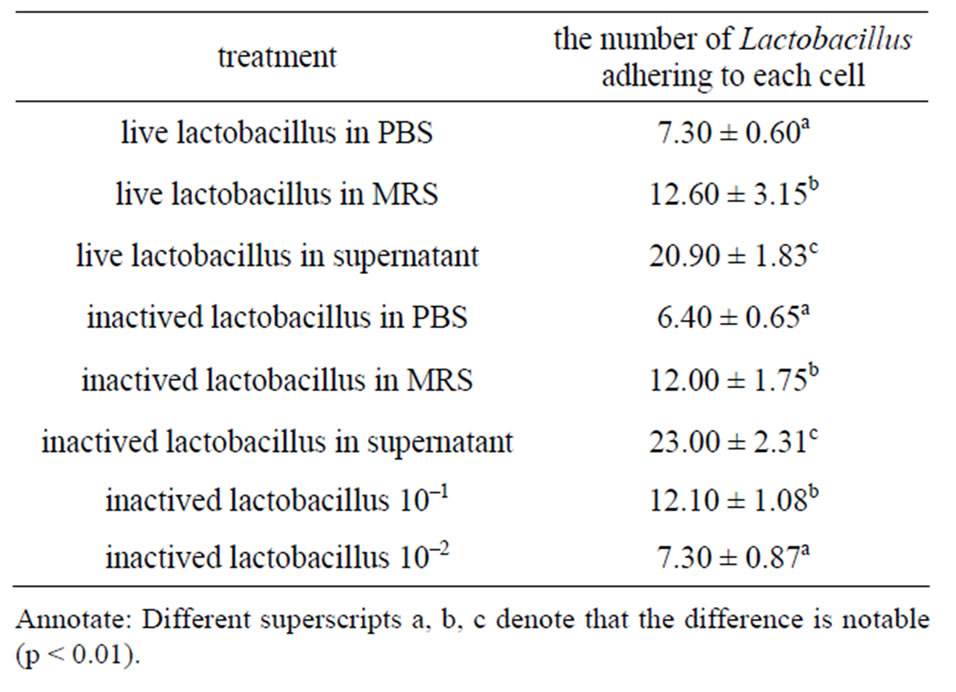
Table 7. Live and inactived Lactobacillus adhesion ability to intestinal epithelial cells.
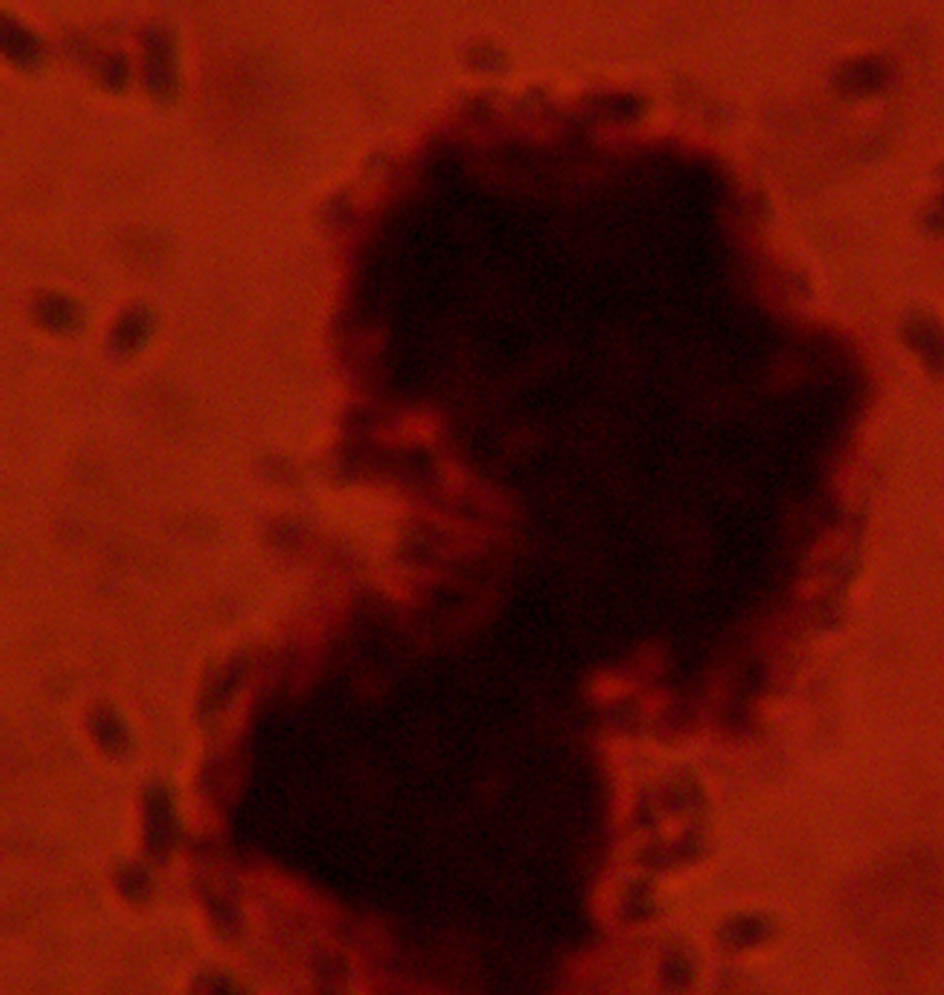
Figure 1. Lactobacillus can firmly adhere to CaCo-2 cells prior to treatment with D-mannose.
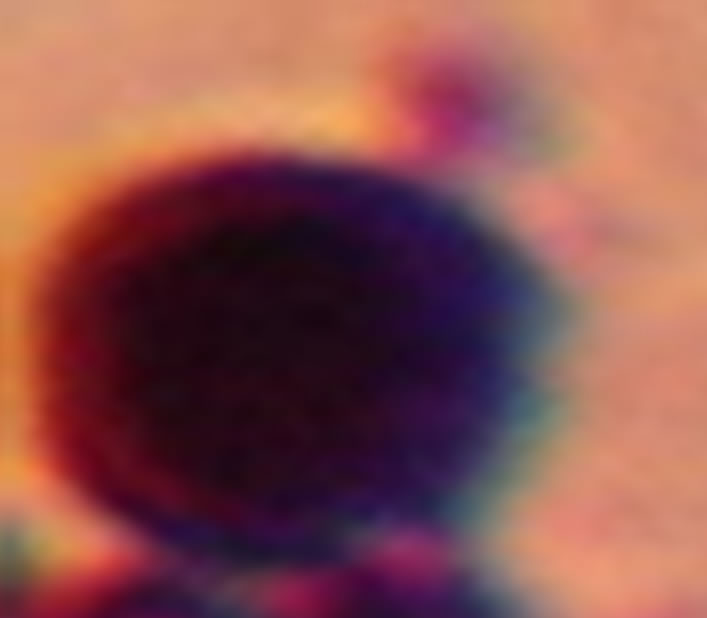
Figure 2. Lactobacillus adhesion to CaCo-2 cells decreased after treatment with D-mannose.
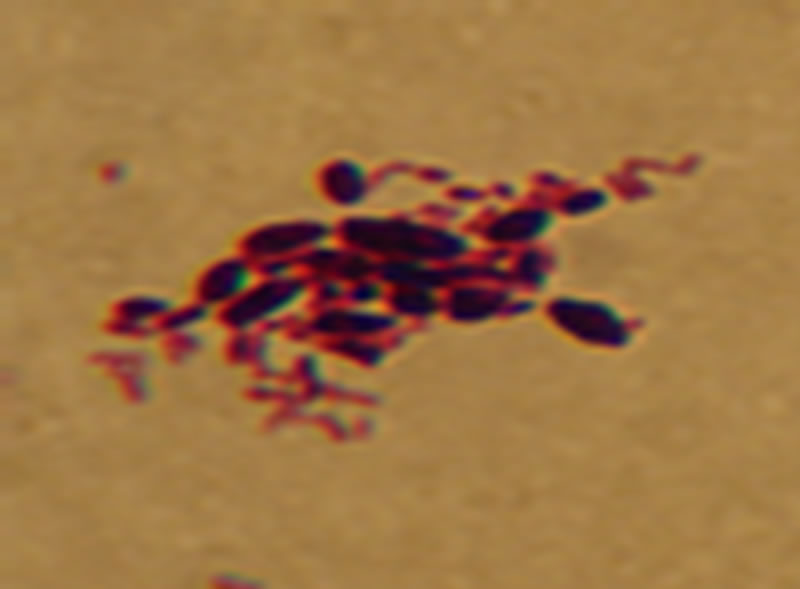
Figure 3. Untreated Lactobacillus can agglutinate to yeast fungus cells.

Figure 4. Lactobacillus agglutination to yeast fungus cells decreases after treatment with D-mannose.
agreement with our findings.
2) Our experimental results demonstrate that Lactobacillus adhesion ability decreased when CaCo-2 cells were incubated with digestive juice containing trypsin but was not true for CaCo-2 cells digested with digestive media containing no trypsin. This result demonstrates that the receptor expressed on the intestinal epithelial cells that is responsible for successful Lactobacillus attachment is likely a protein.
3) Gusilsc (1999) report that certains strains of Lactobacillus can agglutinate yeast fungus cells treated with glutaraldehyde and glycine but the agglutination is inhibited when Lactobacillus is treated with 0.2 M mannose [3]. This result is consistent with the findings of our study.
5. CONCLUSION
Our results indicate that the substance on the surface of Lactobacillus, that promotes adhesion to intestinal epithelial cells, is likely a kind of protein. Based on our findings we also predict that the adhesive substance is present in Lactobacillus supernatants and that the recaptor for this substance is likely a D-mannose glycoprotein receptor expressed by intestinal epithelial cells. Lactobacillus cells were able to agglutinate yeast fungus cells, Lactobacillus receptor above in it is related to mannose, we reveal that both inactived bacteria and live bacteria have a similar ability to adhere to intestinal epithelial cells.
6. ACKNOWLEDGEMENTS
This work was supported by the ministry of Agriculture of China: the earmarked fund for Modern Agro-industry Technology Research System of China and natural science fund of Shandong province (Y2008- D28).
REFERENCES
- Bernet, M.F., Brassart, D., Neeser, J.R. and Servin, A.L. (1994) Lactobacillus acidophilus LA 1 binds to cultured intestinal cell lines and inhibits cell attachment cell invasion by enterovirulen bacteria. Gut, 35, 483-489.
- Gusils, C., Cuozzo, S. and Sesma, F. (2002) Examination of adhensive determinants in three species of lactobacillus isolated from chicken. Canadian Journal of Microbiology, 48, 34-42. doi:10.1139/w01-122
- Gusils, C., Palacios, J. and Gonzalez, S. (1999) Lectinlike protein fractions in lactic acid bacteria isolated from chickens. Biological and Pharmaceutical Bulletin, 22, 11-15. doi:10.1248/bpb.22.11
- Kovalenko, N.K., Kasumova, S.A. and Golovach, T.N. (1990) The adhesion of lactic acid bacteria to the intestinal epithelium of agricultural animals. Mikrobiologicheskii Zhurnal, 52, 76-79.
- Edelman, S., Westerlund-Wikstrom, B., et al. (2002) In vitro adhesion specificity of indigenous lactobacilli within the avian intestinal tract. Applied and Environmental Microbiology, 68, 5155-5159. doi:10.1128/AEM.68.10.5155-5159.2002
NOTES
*Corresponding authors.

